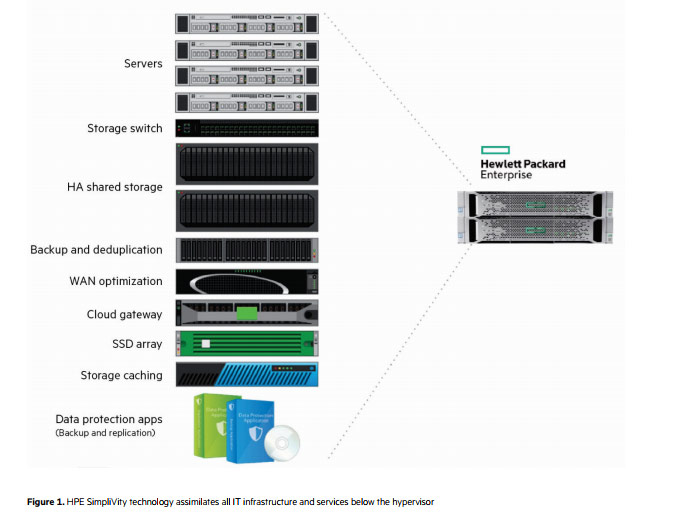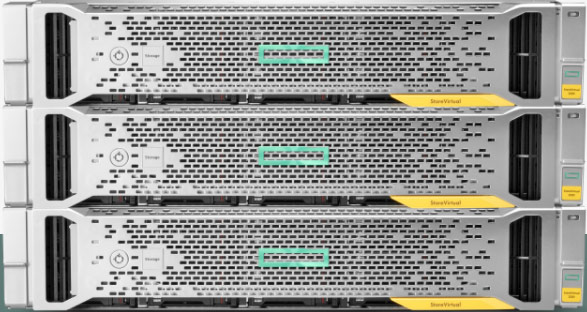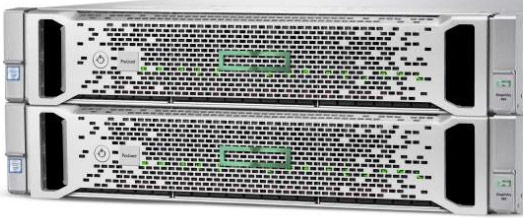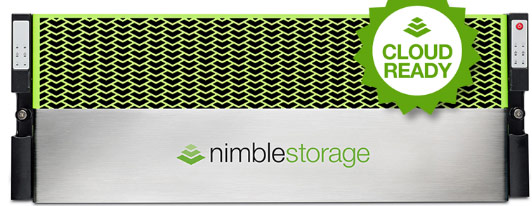In a competitive world where there are multiple HyperConverged platforms to choose from that will integrate storage, compute, memory and virtualization resources into a small hardware form factor appliance supported by a single vendor, I am seeing a growing demand for one platform in particular, HPE’s SimpliVity.
Over the past three months, I have had three requests to refresh an existing array with SimpliVity. I was also recently asked to bring HPE’s SimpliVity into a large enterprise customer’s datacenter to replace their existing HyperConverged platform. Why are businesses looking at SimpliVity?
There seem to be five key factors that are tipping the scales toward SimpliVity:
- SimpliVity accelerates performance by avoiding unneeded IO
- SimpliVity deduplicates everything once and forever globally across applications
- There is no need to have a minimum of three nodes (like competitive vendors) which helps keep costs down
- SimpliVity has a single point of contact for support, regardless if it’s concerning SimpliVity, VMware or hardware (competitors have multiple hardware vendors)
- SimpliVity comes with an industry best integrated backup solution
SimpliVity simply outshines all competition when it comes to backup/restore. All data is deduplicated, and the restore of VMs in almost immediate, regardless of size, even across different datacenters. In one real life example, a customer had a need to restore 2TB of data quickly. The customer concurrently had one System Administrator start the restore process using a “traditional” backup solution, while another System Administrator decided to try to restore using their newly purchased SimpliVity. End result – SimpliVity restored the file server from their DR location across WAN in about 5 seconds. The System Admin then took the affected partition, attached it to the production file server, replacing the corrupted one, and completed the task in about 10 minutes – at which point they cancelled the traditional restore, which had only hit the 10% mark.
Cost and Speed also plays a large part in customers jumping to move to SimpliVity. The cost savings was quickly realized when one of my customers went from seven cabinets at a colocation facility to half a cabinet for SimpliVity, which integrated everything: network equipment, servers, and back-up appliance. Colocation leasing costs are a fraction of what they had been paying, not to mention the additional savings from lower monthly power bills. The significant gains in speed were even more far reaching. SimpliVity brings faster processors and additional RAM, running a flash array, resulting in a huge IOPS gain. This translated to significant gains in development speed seen in SimpliVity’ s ability to immediately clone and deploy virtual machines. If they have a massive surge in server traffic or have to deploy a new program, all they have to do is click on a template. If they need a new database server or an IIS server, their developer simply has to go in and change host names and IP addresses. If they need additional capacity to boot up a test machine, they can spin up extra development VMs in no time. Their network team can replicate a VM from a template, tweak IPs, host names, firewall rules and load balancer settings, and they are good to go.

Its these real-life examples that create rabid fans of SimpliVity once deployed.
Finally, my customers pointed to the SimpliVity OmniStack Accelerator Card as a key differentiator. The Accelerator Card handles the heavy lifting, delivering the required processing power without the high costs. It’s a uniquely architected PCIe module that processes all writes and manages the compute-intensive tasks of deduplication and compression and allows the x86 CPUs to run customers’ business applications. The card is inserted into a HPE DL380 Gen 9 or Gen 10 server providing ultra-fast write processing and caching services that don’t rely on commodity CPUs. The card contains flash and it is also protected by super-capacitors to allow DRAM to be saved in the event of a power loss, making it extremely reliable.
SimpliVity is a radically simplified and dramatically lower-cost infrastructure platform that delivers on the requirements for scalability, flexibility, performance elasticity, data mobility, global management, and cloud integration that today’s IT infrastructures require.
Read this Case Study from a company in Fort Collins, Colorado on how they were able to decrease complexity and increase efficiency of disaster recovery capabilities, while also reducing expenses when they moved to SimpliVity.
Contact Zunesis today to find out more about SimpliVity.
In recent months, HPE has announced two acquisitions that significantly impact their online storage portfolio. In January, it was announced that HPE would be acquiring SimpliVity, a leader in the hyperconverged space. Just two months later, in March, we heard that HPE would be acquiring Nimble, a manufacturer of all-flash and hybrid-flash storage solutions backed by a powerful predictive analytics tool called InfoSight. The acquisition of these two solutions gives HPE one of the strongest storage portfolios in the industry.
The HPE online storage portfolio now includes the following:
• MSA
• StoreVirtual (LeftHand)
• Nimble
• SimpliVity
• 3PAR
So, with so many options, the questions you may be asking are, “Where does each fit into my IT Infrastructure?” or “How do I determine which of these is right for my environment?” There is certainly some overlap amongst these options, but there are also clear reasons why you might choose one over the other.
In this post, I want to provide a summary of each of the solutions and include a few thoughts on why you might consider each as a solution for your environment. I will not cover the XP in this post because it is a solution that has a very narrow set of use cases, and most infrastructure needs will be met by the other online storage solutions in the HPE portfolio.
The solutions are organized here from entry-level to enterprise class.
MSA
 The MSA is a family of storage solutions that’s been around for some time and continues to evolve as storage technologies change. This is generally considered an entry-level array. The MSA two controller array offers Block storage over SAS, Fibre Channel, or iSCSI. Despite its entry-level categorization, the MSA is a solution that can provide up to 960TB of RAW capacity and nearly 200,000 IOPS.
The MSA is a family of storage solutions that’s been around for some time and continues to evolve as storage technologies change. This is generally considered an entry-level array. The MSA two controller array offers Block storage over SAS, Fibre Channel, or iSCSI. Despite its entry-level categorization, the MSA is a solution that can provide up to 960TB of RAW capacity and nearly 200,000 IOPS.
In addition to the capacity and performance, this array provides some impressive features, including:
– Thin Provisioning
– Automated Tiering
– Snapshots
– Array-based Replication
– Quality of Service
Consider the MSA if you are trying to meet the needs of a few hosts with a predictable workload profile. This solution is designed with smaller deployments in mind and where affordability is a key factor. If you are looking for deduplication, compression, or plan to scale your environment significantly, the MSA is not for you. We have used the MSA for small VMware environments and as Disk Targets in a backup solution.
StoreVirtual
 StoreVirtual defines an operating system for providing scale-out, software defined storage solutions. StoreVirtual is based on the LeftHand operating system. LeftHand was a company HP acquired in October of 2008 to give them an iSCSI solution in their portfolio. The LeftHand Operating System is designed to run on most x86-based hardware and can be deployed as a virtual machine, a hyperconverged appliance, or as a dedicated storage array.
StoreVirtual defines an operating system for providing scale-out, software defined storage solutions. StoreVirtual is based on the LeftHand operating system. LeftHand was a company HP acquired in October of 2008 to give them an iSCSI solution in their portfolio. The LeftHand Operating System is designed to run on most x86-based hardware and can be deployed as a virtual machine, a hyperconverged appliance, or as a dedicated storage array.
Regardless of how it is deployed, the StoreVirtual solution provides block storage over iSCSI or Fibre Channel. Capacities can vary depending on the method that is deployed but can go up to 576TB of RAW capacity on the SV3200 Appliance Storage Node.
The StoreVirtual uses an all-inclusive licensing model, and the feature set includes:
– Thin Provisioning
– Automated Tiering
– Snapshots
– Array-based Replication
– Multi-site Stretch Clusters
– Built-in Reporting
Like the MSA, StoreVirtual is intended for smaller deployments with predictable workloads. As a scale-out solution, the StoreVirtual provides an easy path for increasing capacity and performance simultaneously by adding one or more StoreVirtual Nodes. The StoreVirtual solution is a relatively affordable solution for the features it provides. And, if you are looking to take advantage of existing compute and storage hardware, StoreVirtual may be a good choice. We see the StoreVirtual solutions deployed in smaller to mid-sized virtual environments.
SimpliVity
 To be clear, SimpliVity is not a standalone, online storage solution. It is a hyperconverged solution that provides Storage, Compute, and Networking services in one converged solution. I am including it in these summaries because it includes storage as an important part of the overall solution and would be an alternative to needing to provide a separate storage solution for your VMware environment.
To be clear, SimpliVity is not a standalone, online storage solution. It is a hyperconverged solution that provides Storage, Compute, and Networking services in one converged solution. I am including it in these summaries because it includes storage as an important part of the overall solution and would be an alternative to needing to provide a separate storage solution for your VMware environment.
SimpliVity is specifically designed to provide all the infrastructure beneath the hypervisor layer. At this time, it is specifically for VMware environments. As a converged solution, SimpliVity provides everything you would need to support your environment. (Yes, that means backup as well!)
Here is a list of the features you’ll find in a SimpliVity solution:
– Servers & VMware
– Storage Switch
– HA Shared Storage
– Backup & Dedupe
– WAN Optimization
– Cloud Gateway
– SSD Array
– Storage Caching
– Data Protection Apps (Backup & Replication)
– Deduplication
– Compression
This solution is going to be more expensive than the MSA or StoreVirtual offerings; but, again, it provides all the infrastructure for your VMware environment. It’s more than just a storage solution. So, if you are looking to consolidate your infrastructure significantly and the workloads you are supporting have all been virtualized on VMware, this solution may be worth looking at for you.
Nimble
 The Nimble solutions offer Block storage in all-flash and hybrid-flash models delivered over iSCSI or Fibre Channel. The current offering from HPE will provide up to 294TB of RAW capacity on the hybrid-flash solution. Of course, compression and deduplication will provide much greater effective capacity dependent on data types.
The Nimble solutions offer Block storage in all-flash and hybrid-flash models delivered over iSCSI or Fibre Channel. The current offering from HPE will provide up to 294TB of RAW capacity on the hybrid-flash solution. Of course, compression and deduplication will provide much greater effective capacity dependent on data types.
The all-inclusive features of the Nimble family include:
– Thin Provisioning
– Automated Tiering
– Application Aware Snapshots
– Deduplication (all-flash)
– Quality of Service (all-flash)
– Array-based Replication
– Encryption
– InfoSight Predictive Analytics
This solution is designed to handle mixed-workloads and is perfect for mid-sized virtualized environments. InfoSight Predictive Analytics is a significant part of this solution, and I wouldn’t be surprised if it were integrated with other HPE storage solutions in the future.
Taken directly from the HPE QuickSpecs, the InfoSight Analytics provide:
– Proactive resolution. InfoSight automatically predicts and resolves 86% of problems before you even know there is an issue.
– Solves storage and non-storage problems. By collecting and correlating sensors across the infrastructure stack, InfoSight uncovers problems spanning from storage to VMs. In fact, 54% of the problems InfoSight resolves are outside of storage.
– Prevents known issues with infrastructure that learns. If a problem is detected in one system, InfoSight begins to predict the issue and inoculate other systems. Every system gets smarter and more reliable through collective installed base insights.
– The support you’ve always wanted. Automation and proactive resolution put the focus on prevention, streamlining the process, and connecting you directly to support expertise. No more answering routine support questions, sending log files, or attempting to recreate issues.
Nimble should be a consideration for any virtualized environment where you are looking for ease of use, great reporting, and performance.
3PAR
 Of course, this has been the workhorse for the enterprise storage offering from HPE since 2010. Depending on the model, the 3PAR Solution can start with 2 Controllers and go up to 8 Controllers for a single array. The 3PAR has both a hybrid and an all-flash solution. Capacities can scale to 6PB RAW in the new 9000 series of the 3PAR family. The 3PAR array delivers Block over iSCSI and Fibre Channel and can also supports SMB, NFS, and FTP/FTPS natively.
Of course, this has been the workhorse for the enterprise storage offering from HPE since 2010. Depending on the model, the 3PAR Solution can start with 2 Controllers and go up to 8 Controllers for a single array. The 3PAR has both a hybrid and an all-flash solution. Capacities can scale to 6PB RAW in the new 9000 series of the 3PAR family. The 3PAR array delivers Block over iSCSI and Fibre Channel and can also supports SMB, NFS, and FTP/FTPS natively.
The all-inclusive feature set includes:
– Thin Provisioning
– Thin Deduplication
– Thin Compression
– Snapshots
– Array-based Replication (add-on license)
– File Persona (SMB, NFS, FTP/FTPS)
– Automated Tiering
– Flash Cache
– Quality of Service
– Non-disruptive LUN Migration
– Array to Array Migration
– Reporting
– Multi-Tenancy
The 3PAR Array should be considered for a multi-workload environment where performance, availability, and scale are the top priorities.
Which One Is Right for You?
As mentioned at the beginning of the post, the goal here was to provide a summary of the primary online storage solutions now offered by HPE and to give a little guidance on where they might fit. Each of these solutions represent a different architecture, and those architectures should be understood clearly before making any final decisions. At Zunesis, we can help you understand which of these solutions might fit your needs and can walk you through the architectures of each.

